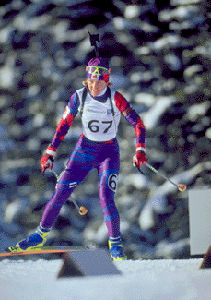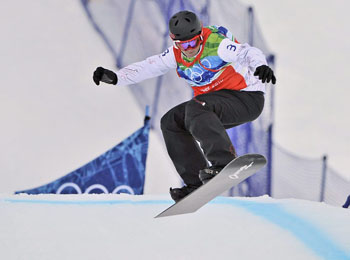Nancy Catherine “Tiger” Greene Raine, OC, OBC, alpine skier (born 11 May 1943 in Ottawa, ON). Olympic gold medallist Nancy Greene was named Canada’s best female athlete of the 20th century by the Canadian Press. A two-time World Cup alpine skiing champion, Greene competed in slalom, giant slalom and downhill. Her fierce and aggressive style earned her the nickname “Tiger.” Her 13 World Cup victories are the most ever by a Canadian. Greene received the Lou Marsh Trophy (now the Northern Star Award) as Canada’s athlete of the year in 1967 and 1968. She retired from skiing at the age of 24 and later became a member of the Senate of Canada (2009–18). She has been inducted into Canada’s Sports Hall of Fame, the British Columbia Sports Hall of Fame and Museum, the Canadian Ski Hall of Fame, the US Ski and Snowboarding Hall of Fame and Canada’s Walk of Fame.

Early Life
Nancy Greene was born 11 May 1943 in Ottawa, Ontario. During the Second World War, her parents, native British Columbians, were living in Canada’s capital, where Greene’s father, Bob, worked for the government. Following the war, the family moved back west and settled in Rossland, BC.
Growing up, Greene and her five siblings were avid recreational skiers and founding members of the nearby Red Mountain Ski Club. Following in the footsteps of her older sister, Elizabeth, Greene began competitive ski racing at the age of 14.
In 1958, Greene was an injury replacement at the Canadian Juniour Championships, which took place in Rossland at Red Mountain. Greene’s performance on her familiar home course earned her a spot in the championship the following year; she finished seventh after suffering an injury during a fall. Greene’s aggressive and attacking style on the slopes earned her the nickname “Tiger.”
Despite her subpar performance, she caught the eye of Canadian Olympic coach Pepi Salvenmoser and was invited to trials for the 1960 Winter Olympic team. She made the team as an alternate and made her Olympic debut at the Olympic Winter Games in Squaw Valley (now Olympic Valley), California. She competed in the giant slalom, slalom and downhill races. Greene’s best finish was in 22nd place.
Her showing at the 1964 Olympics in Innsbruck, Austria, showed signs of improvement; she finished seventh in the downhill. But her breakout season came in 1965 at age 21, when she finished in first place at the Bingham Cup American ski championships. It was one of nine first-place finishes for her that year.

World Cup
The inaugural World Cup took place in 1967. Greene dominated on the new stage, a series of races taking place in various countries between January and March, culminating in the crowning of an overall winner.
On 7 and 8 January 1967 in Oberstaufen, Germany, Greene won her first two World Cup races in giant slalom and slalom. Three days later, in Grindewald, Switzerland, she repeated the feat. Greene went on to finish first place in Vail, Colorado, and at Jackson Hole, Wyoming. She finished the World Cup with seven first-place victories and two third-place results. With 176 overall points, she earned the World Cup championship.
Greene was awarded the 1967 Lou Marsh Trophy as Canada’s athlete of the year. She was also made an Officer of the Order of Canada that year.
Her performance set the stage for the 1968 World Cup. Greene continued where she left off, winning six races. She finished fourth overall in downhill and slalom and first overall in giant slalom. For the second consecutive year, she was the overall points leader and World Cup champion. Her 13 World Cup victories remain the most ever by a Canadian.

1968 Winter Olympics
By the time of the 1968 Olympic Winter Games in Grenoble, France, Greene was considered a medal favourite. She did not disappoint. On 13 February, Greene finished in second place in the slalom race, earning a silver medal. Two days later, on 15 February, Greene took home the gold medal in giant slalom with a wide margin of 2.68 seconds.
For the second year in a row, Greene was voted Canada’s top athlete, capturing another Lou Marsh Trophy in 1968.
Greene retired from skiing at the age of 24, amassing 17 Canadian Championship titles over her illustrious career. In 1999, the Canadian Press named her the Canadian female athlete of the century.
Post-Skiing Career
After her athletic career, Greene became a popular spokesperson. In 1968, she joined Prime Minister Pierre Trudeau’s Task Force on Sport, where she met Al Raine, who had just been named director of Canada’s national ski team. The two were married in August 1969 and had twin sons, Charley and Willy Raine, in 1970. Willy went on to compete in alpine racing at the 1992 Olympic Winter Games in Albertville, France.
Greene continued to be an ambassador for the sport as the family settled in British Columbia. She served on the administrative boards at several alpine resorts, including Sun Peaks, near Kamloops, where she was director. Greene was named ambassador of the 2010 Olympic Winter Games in Vancouver.
Senator
In 2009, Greene was appointed to the Senate of Canada by Prime Minister Stephen Harper. She represented the Conservative Party and held the position until her mandatory retirement in 2018 at the age of 75. She was involved in such notable legislation as the Medical Assistance in Dying (MAID) Act and sponsored Bill S-228, which would prohibit the marketing of unhealthy food and beverages to children.
See also Women and Sport; The History of Canadian Women in Sport.
Honours and Awards
- Officer, Order of Canada (1967)
- Female Athlete of the Year, Amateur Athletic Union (1967)
- Inductee, Canada’s Sports Hall of Fame (1967)
- Lou Marsh Trophy (1967, 1968)
- Member, Order of the Dogwood (1968)
- Inductee, British Columbia Sports Hall of Fame and Museum (1969)
- Inductee, US Ski and Snowboard Hall of Fame (1969)
- Inductee, Canadian Ski Hall of Fame (1992)
- Inductee, Canada’s Walk of Fame (1999)
- Doctor of Laws, University College of the Cariboo (1999)
- Doctor of Laws, Royal Roads University (2002)
- Doctor of Laws, Simon Fraser University (2004)
- Member, Order of British Columbia (2004)

 Share on Facebook
Share on Facebook Share on X
Share on X Share by Email
Share by Email Share on Google Classroom
Share on Google Classroom






